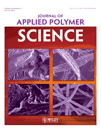Crystal structure and orientation of uniaxially and biaxially oriented PLA and PP nanoclay composite films
Abstract
Cast films of poly(lactic acid) (PLA) and polypropylene (PP) with 2.5 and 5 wt % organo modified nanoclay were prepared and then uniaxially and biaxially hot drawn at T = 90 and 155°C, respectively, using a biaxial stretcher. The orientation of PLA and PP crystal unit cells, alignment of clay platelets, as well as the extent of intercalation and exfoliation were studied using wide angle X-ray diffraction (WAXD). The measurement of d-spacing of the 001 plane (normal to platelets plane) of the clay tactoids indicated the intercalation of the silicate layers for the PLA nanocomposite films, whereas the PP nanofilled films showed only dispersion of the nanoparticles (i.e., neither intercalation nor exfoliation were observed). The intercalation level of the clay platelets in PLA was almost identical for the uniaxially and biaxially drawn films. Our finding showed that the crystallite unit cell alignments are appreciably dependent on uniaxial and biaxial stretching. Moreover, the incorporation of clay to some extent influenced the orientation of the crystal unit cell axes (a, b, and c) of the oriented films. The silicate layers revealed a much higher orientation into the flow direction in the uniaxially stretched films compared to the biaxially drawn samples. In addition, the orientation of the 001 plane of nanoclays was significantly greater in the PLA compared to the PP nanoclay composite films probably due to a better intercalation and stress transfer in the former. Morphological pictograms illustrating the effects of uniaxial and biaxial stretching on the clay orientation are proposed. © 2011 Wiley Periodicals, Inc. J Appl Polym Sci, 2011




